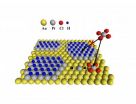Click here for more information.
A computer model of the heart wall predicted risk of irregular heart rhythms and sudden cardiac death in patients, paving the way for the use of more complex cardiac models to calculate the consequences of genetic, lifestyle and other changes to the heart.
Authors of the new study, published in the Journal of the American College of Cardiology, say this is the first report of cardiac modeling being used as an arrhythmic risk predictor for patients.
"This is a strong proof-of-principle study showing that computer simulation can be used to predict risk of cardiac arrhythmias," said Coeli M. Lopes, Ph.D., lead study author and assistant professor at the Aab Cardiovascular Research Institute at the University of Rochester Medical Center. "With this model we can determine the influence of a single mutation on the much bigger overall response of the heart."
With this study under their belts, the research team, including several scientists from the Medical Center, the IBM T.J. Watson Research Center in Yorktown Heights, N.Y and the IBM Research Collaboratory for Life Sciences in Melbourne, Australia is pursuing a much more sophisticated model of the whole human heart. They plan to predict the effects of new drugs on the electrical activity of the heart – one of the most challenging hurdles in the development of new drugs and an extremely important part of keeping potentially dangerous drugs off the market.
The computer model, designed by IBM scientists Matthias Reumann, Ph.D., and J. Jeremy Rice, Ph.D., includes 192 heart cells made to function electrically like the ventricle wall by assigning varying properties to cells based on their position – inside, middle, or outside – in the heart wall. The IBM scientists used canine cardiac cells as a guide, adapting the model cells to act more like ours based on extensive data on the electrical properties of the human heart. In the end, the simulation requires the solution of more than 100,000 complex mathematical equations at least 1,000 times over just to simulate a single heartbeat.
The team turned to more than 600 patients with Long QT syndrome type 1 – an inherited disorder that puts patients at greater risk of arrhythmias and sudden cardiac death – to help test the model. Patients were drawn from Long QT syndrome registries from the United States, Japan, the Netherlands, Denmark and Sweden.
Patients with the disorder have mutations in a specific gene, KCNQ1, which helps heart cells appropriately generate and transmit electrical signals. The study used 34 different mutations to the gene, identified with patient blood samples and genetic tests. To better understand the characteristics of each mutation – how they act and the defects they cause – the team recreated all of the mutant proteins in the lab and tested them in various cell lines.
Researchers plugged each mutation's electrical profile into the model to simulate the mutation's effect on the heart wall. The model produced a one-dimensional, transmural (across the heart wall) electrocardiogram or ECG for each mutation, which predicts how the mutation influences the electrical properties of the heart wall as it is excited and relaxes after each beat.
When the team compared this information to patient data, analyses revealed that mutations the model predicted would strongly prolong repolarization – the time it takes for the heart wall to recover after each beat – put patients at greater risk of potentially life-threatening events. For every 10 milliseconds that repolarization was delayed a patient's risk of sudden cardiac death or aborted cardiac arrest rose by approximately one third.
The authors note that this risk is separate from the increased risk observed for patients that show a very prolonged repolarization on traditional ECGs, when electrodes are placed on the skin and attached to a machine that records the heart's electrical signals. They suggest that the computer simulation may reflect a lifelong risk of heart rhythm problems, while the conventional ECG may show only a single point in time.
They identified four high-risk mutations that were predicted to have particularly extended repolarization periods and determined that patients with these mutations experienced the greatest number of cardiac events.
Study authors say the results show that a relatively simple model, used in the right hands with the proper experimental data, can give insight into complex ECGs from real patients. "Using this model, we can predict the likelihood that an individual will experience a deadly cardiac event based on the type of mutation they have and how that mutation acts," noted Lopes.
Rice, a seasoned cardiac modeler that led the IBM team, adds, "This is a very powerful study because we used so many different mutations. Oftentimes, scientists will study only one mutation at a time, and the research community remains unconvinced as the right answer may have come by luck. By comparing our results to so much patient data, we've shown that you can get meaningful information out of computer models, hopefully paving the way for wider acceptance and use in the medical community."
Arthur J. Moss, M.D., a world-renowned expert on electrical disturbances of the heart, says that research has shown that the location of a mutation plays an important role in assessing risk, but this is the first time scientists have used the function of a mutation to identify patients at higher risk.
"This kind of movement, from identifying a mutation, to locating where it is, and now to evaluating how the mutation functions, is going to happen in every area of medicine, from heart disease to cancer," said Moss, a study author and longtime professor of Cardiology at the University of Rochester Medical Center. "This type of knowledge is going to help us better predict risk for each individual patient and provide more aggressive prevention and treatment strategies for those who need it."
Moss adds that the research exemplifies a strong trend in medicine where practitioners are moving away from diagnosing disease primarily by signs and symptoms and instead focusing more on the basic genetic aspects of specific ailments.
Computer models of the human heart have been in development since the 1960's, but the authors believe they are the first to publish a study demonstrating that they can be used to generate clinically relevant information that predicts patient risk.
Lopes and Rice, along with Jean-Phillippe Couderc, Ph.D., M.B.A., a biomedical engineer and cardiology researcher at the Medical Center, are taking their model to the next level with the use of IBM's next generation supercomputer, the Blue Gene/Q, which was recently installed in the University of Rochester's Health Sciences Center for Computational Innovation. It is one of the most powerful and efficient computer systems in the world and enables scientists to sift through mountains of data and create complex models. The team plans on using the supercomputer to generate a gender-specific model to better understand which drugs may cause lethal disruptions of the heart's electrical activity.
### The study was funded by the National Heart, Lung and Blood Institute at the National Institutes of Health. In addition to Lopes, Ryan Hoefen, M.D. Ph.D., Ilan Goldenberg, M.D., Arthur J. Moss, M.D., Jin O-Uchi, M.D., Ph.D., Scott McNitt, Wojciech Zareba, M.D., Ph.D., and Christian Jons, M.D., from the University of Rochester Medical Center participated in the research. Along with Rice, Matthias Reumann, Ph.D., and Yiping Gu, PhD, from the IBM research team worked on the computer model. Scientists from the University of Copenhagen in Denmark, the National Cardiovascular Center in Japan, the University of Amsterdam in the Netherlands, and the Lund University in Sweden participated in the research as well.



